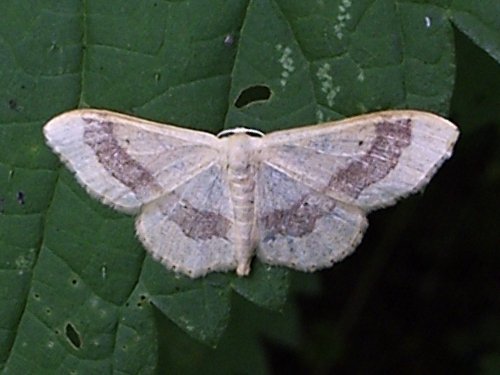- Riband Wave
Taxobox
name = Riband Wave

image_width = 240px
image_caption = "Idaea aversata",
sitting on anettle leaf
regnum =Animal ia
phylum =Arthropod a
classis =Insect a
ordo =Lepidoptera
familia =Geometridae
subfamilia =Sterrhinae
genus = "Idaea"
species = "I. aversata"
binomial = "Idaea aversata"
binomial_authority = Linnaeus,1758 The Riband Wave "(Idaea aversata)" is amoth of the familyGeometridae . It is an abundant species inEurope , theNear East and NorthAfrica , its distinctive outline familiar at lighted windows.The species has a
wingspan of 30-35 mm. The wings are buff or cream with darkfascia . Two main forms exist, equally abundant: One has darker shading between the central fascia (as in the picture), the other has not. The adults fly at night from June to August, occasionally later ref|flight_season, and are attracted to light.The
larva is brown, tapering towards the front, and feeds on a variety of plants including bedstraw,chickweed ,dandelion andknotgrass . The species overwinters as a small larva.#Note|flight_season"The flight season refers to the
British Isles . This may vary in other parts of the range."External links
* [http://www.funet.fi/pub/sci/bio/life/insecta/lepidoptera/ditrysia/geometroidea/geometridae/sterrhinae/idaea/index.html#aversata Riband Wave at Markku Savela's Lepidoptera pages]
References
Chinery, Michael "Collins Guide to the Insects of Britain and Western Europe" 1986 (Reprinted 1991)
Skinner, Bernard "Colour Identification Guide to Moths of the British Isles" 1984
Wikimedia Foundation. 2010.
